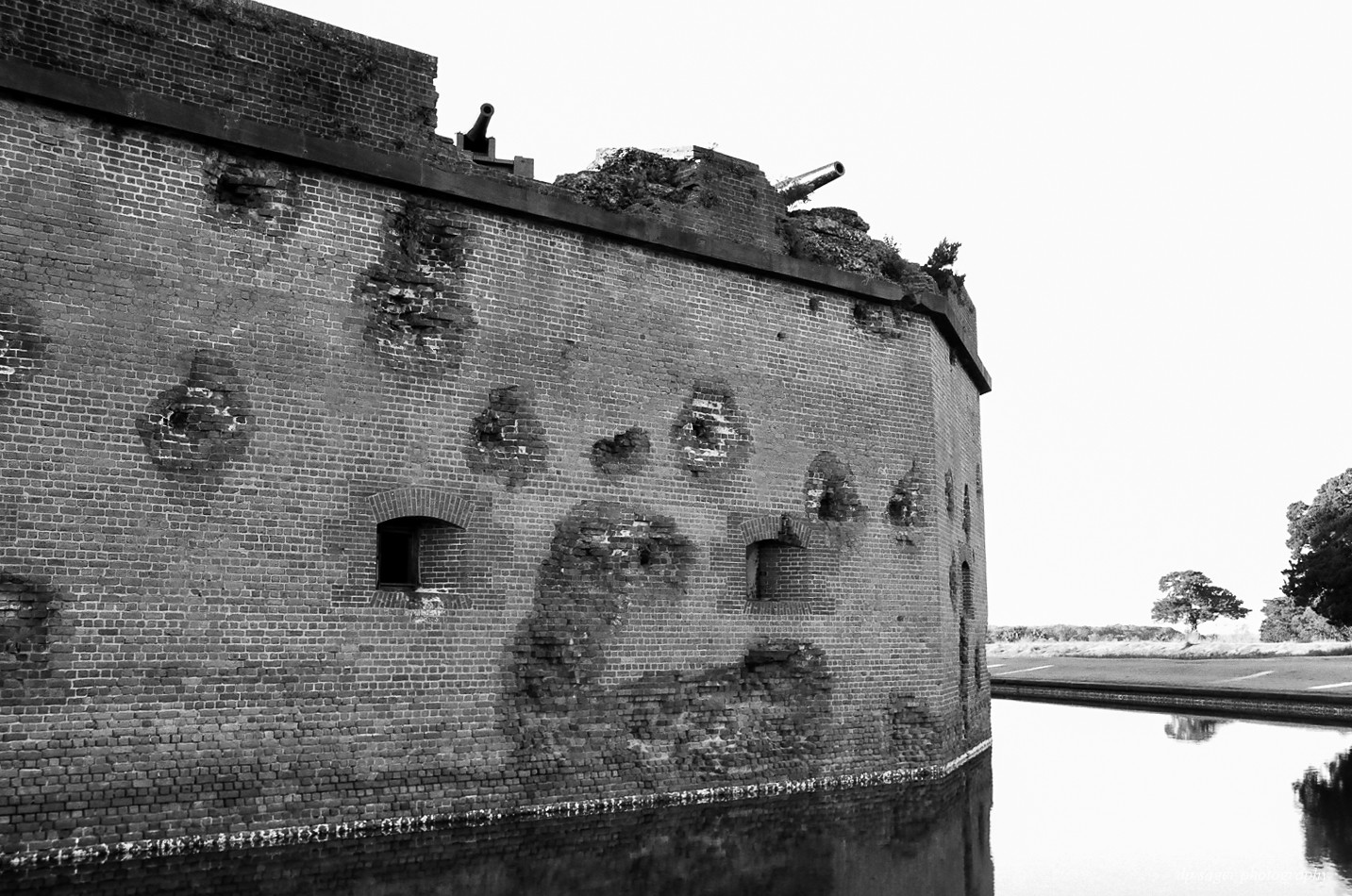Fort Pulaski National Monument
Dec 11, 2020 07:04:57 #
Fort Pulaski
Cockspur Island, Georgia
Nov 2014
Fort Pulaski National Monument is located on Cockspur Island between Savannah and Tybee Island, Georgia. The monument preserves Fort Pulaski, where in 1862 during the American Civil War, the Union Army successfully tested rifled cannon in combat, the success of which rendered brick fortifications obsolete.
Fort Pulaski National Monument by Paul Sager, on Flickr

Following the War of 1812, U.S. President James Madison ordered a new system of coastal fortifications to protect the United States against foreign invasion. Construction of a fort to protect the port of Savannah began in 1829 under the direction of Major General Babcock, and later Second Lieutenant Robert E. Lee, a recent graduate of West Point. The new fort would be located on Cockspur Island at the mouth of the Savannah River.
Fort Pulaski National Monument

Fort Pulaski belonged to what is known as the Third System of coastal fortifications, which were characterized by greater structural durability than the earlier works. Most of the nearly thirty Third System forts built after 1816 still exist along either the Atlantic or Gulf coasts.
Fort Pulaski National Monument

The fort is named after Casimir Pulaski, a Revolutionary War soldier under George Washington’s command. An estimated 25 million bricks were used to build the fort, with walls eleven feet thick that were thought to be impenetrable. Lt. Lee remarked that "one might as well bombard the Rocky Mountains as Fort Pulaski".
Fort Pulaski National Monument

Images shared in this post come from an EOS 5DIII and EOS 1v using Ilford Delta 100. Lenses are the EF 50mm f/1.8 and EF 35mm f/1.4L.
Fort Pulaski National Monument

Georgia seceded from the Union in February 1861, joining the Confederate States of America in what would shortly become the U.S. Civil War. On the morning of April 10, 1862 Union forces asked for the surrender of the Fort to prevent needless loss of life. Colonel Charles H. Olmstead, commander of the Confederate garrison, rejected the offer.
Using 36 guns, including the new James Rifled Cannon and Parrott rifles, Union troops began a sustained bombardment of Fort Pulaski. The rifled projectiles could be accurately fired farther (4-5 miles) than the larger and heavier smoothbore cannonballs. Within 30 hours, the new rifled cannon had breached one of the fort's corner walls. Shells now passed through the fort dangerously close to the main powder magazine. The Confederate defenders then surrendered the fort.
Fort Pulaski National Monument

Fort Pulaski was declared a National Monument in October 1924 as a last measure to save the building from ruin, which had been for the most part unused since the end of the war in 1865.
Fort Pulaski National Monument

The National Monument includes most of Cockspur Island (containing the fort) and all of adjacent McQueens Island. The fort was listed on the National Register of Historic Places on October 15, 1966. Fort Pulaski remains open to the public, with a museum opened in the 1980s.
Fort Pulaski National Monument

These images are sized to fill your wide-screen display. Try using <F11> to maximize your browser window for the full effect. If the images overshoot your display, such as a laptop, just click on the image or the URL link and they'll resize to your screen from the host Flickr site. You can click a bit further into the image details on the Flickr page, if desired. EXIF data is available from the host Flickr pages as well. On the Flickr site, use your <L>key for Large and the <F11> for the full-screen.
Cockspur Island, Georgia
Nov 2014
Fort Pulaski National Monument is located on Cockspur Island between Savannah and Tybee Island, Georgia. The monument preserves Fort Pulaski, where in 1862 during the American Civil War, the Union Army successfully tested rifled cannon in combat, the success of which rendered brick fortifications obsolete.
Fort Pulaski National Monument by Paul Sager, on Flickr

Following the War of 1812, U.S. President James Madison ordered a new system of coastal fortifications to protect the United States against foreign invasion. Construction of a fort to protect the port of Savannah began in 1829 under the direction of Major General Babcock, and later Second Lieutenant Robert E. Lee, a recent graduate of West Point. The new fort would be located on Cockspur Island at the mouth of the Savannah River.
Fort Pulaski National Monument

Fort Pulaski belonged to what is known as the Third System of coastal fortifications, which were characterized by greater structural durability than the earlier works. Most of the nearly thirty Third System forts built after 1816 still exist along either the Atlantic or Gulf coasts.
Fort Pulaski National Monument

The fort is named after Casimir Pulaski, a Revolutionary War soldier under George Washington’s command. An estimated 25 million bricks were used to build the fort, with walls eleven feet thick that were thought to be impenetrable. Lt. Lee remarked that "one might as well bombard the Rocky Mountains as Fort Pulaski".
Fort Pulaski National Monument

Images shared in this post come from an EOS 5DIII and EOS 1v using Ilford Delta 100. Lenses are the EF 50mm f/1.8 and EF 35mm f/1.4L.
Fort Pulaski National Monument

Georgia seceded from the Union in February 1861, joining the Confederate States of America in what would shortly become the U.S. Civil War. On the morning of April 10, 1862 Union forces asked for the surrender of the Fort to prevent needless loss of life. Colonel Charles H. Olmstead, commander of the Confederate garrison, rejected the offer.
Using 36 guns, including the new James Rifled Cannon and Parrott rifles, Union troops began a sustained bombardment of Fort Pulaski. The rifled projectiles could be accurately fired farther (4-5 miles) than the larger and heavier smoothbore cannonballs. Within 30 hours, the new rifled cannon had breached one of the fort's corner walls. Shells now passed through the fort dangerously close to the main powder magazine. The Confederate defenders then surrendered the fort.
Fort Pulaski National Monument

Fort Pulaski was declared a National Monument in October 1924 as a last measure to save the building from ruin, which had been for the most part unused since the end of the war in 1865.
Fort Pulaski National Monument

The National Monument includes most of Cockspur Island (containing the fort) and all of adjacent McQueens Island. The fort was listed on the National Register of Historic Places on October 15, 1966. Fort Pulaski remains open to the public, with a museum opened in the 1980s.
Fort Pulaski National Monument

These images are sized to fill your wide-screen display. Try using <F11> to maximize your browser window for the full effect. If the images overshoot your display, such as a laptop, just click on the image or the URL link and they'll resize to your screen from the host Flickr site. You can click a bit further into the image details on the Flickr page, if desired. EXIF data is available from the host Flickr pages as well. On the Flickr site, use your <L>key for Large and the <F11> for the full-screen.
Dec 11, 2020 07:12:00 #
Dec 11, 2020 07:39:05 #
Dec 11, 2020 07:47:29 #
Nice photos and interesting, Paul! That looks like a place I need to see.
Dec 11, 2020 07:51:47 #
Thank you tradio, ShelbyDave, jaymatt! The rifled cannons blasted a hole through the wall rather quickly. The newer looking brick section of the final image is the rebuilt wall, but I forget when that repair work was done. The Union occupied the fort after the battle, but it was mostly unused for anything from the end of the war onward.
Dec 11, 2020 07:55:47 #
Dec 11, 2020 16:02:14 #
Great set, Paul. Love the photos and history. It must have been terrifying inside the Fort when those rounds breached the wall.
Dec 12, 2020 00:47:56 #
Thank you starlifter, Joe! Yes, it would be quite a worry knowing you're holding a fort where they're blasting a hole through the wall at the powder magazine.
Dec 12, 2020 07:10:42 #
CHG_CANON wrote:
Fort Pulaski br Cockspur Island, Georgia br Nov 20... (show quote)
Another fine set Paul. Nice DOF and detail in the images. Thanks
Dec 12, 2020 07:25:43 #
Dec 12, 2020 08:18:45 #
CHG_CANON wrote:
Fort Pulaski br Cockspur Island, Georgia br Nov 20... (show quote)
Nice set and commentary! I just returned from Jekyll Island, passing up the trip to Fort Pulaski. With your post, it seems like I was actually there, almost. Thanks.
Dec 12, 2020 08:27:40 #
Dec 12, 2020 08:34:25 #
Archboo3
Loc: Central Florida
Thanks for sharing. I have driven by this fort on business many a time saying one day I'm coming back for a visit. After seeing your pictures I now I am now going to make that happen.
Dec 12, 2020 08:54:09 #
Fantastic pictures and great narrative of Fort Pulaski.
Fort Castillo de San Marcos in St. Augustine Florida suffered the same fate. It was impenetrable against cannon balls. Once the rifled artillery was developed it was a different story. During the Civil War a Union warship entered the harbor and the fort was surrendered by town officials as they did not want to see it destroyed.
Fort Castillo de San Marcos in St. Augustine Florida suffered the same fate. It was impenetrable against cannon balls. Once the rifled artillery was developed it was a different story. During the Civil War a Union warship entered the harbor and the fort was surrendered by town officials as they did not want to see it destroyed.
Dec 12, 2020 09:23:36 #
If you want to reply, then register here. Registration is free and your account is created instantly, so you can post right away.







